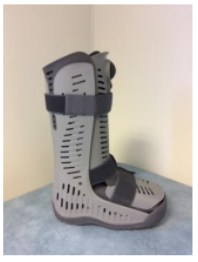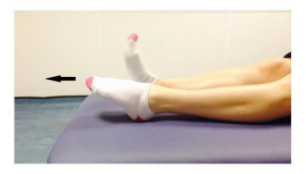This leaflet answers common questions about suspected achilles tendon Injuries. If you would like further information, or have any worries, please do not hesitate to ask your nearest clinician.

What is a suspected achilles tendon injury?
This is a possible tear to the tendon at the back of your ankle
Healing
If confirmed, this normally takes approximately nine to ten weeks to heal. Full rehabilitation can take one year. You may have an ultrasound scan to assess the tendon to confirm your diagnosis. Smoking will slow down your healing. We would advise that you stop smoking while your fracture heals. Talk to your GP for more information.
Pain and swelling
Your ankle may be swollen, and you will have some pain. Swelling is often worse at the end of the day. Taking pain medication and elevating your ankle will help.
Wearing your boot
You must use the boot with wedges. Keep the boot on all the time, including in bed at night. Always wear a sock in the boot. Please tell us if you are diabetic; you may need a special boot. You are allowed to put weight through your foot.
You may find it easier to use crutches in the early stages. Follow up: You may have been referred for an ultrasound scan. If this is the case, the Virtual Fracture Clinic team will call you to discuss the results of your scan and the next stage of your care.

Caring for your injury
Personal Hygiene: You should remove the boot carefully for washing and to change your sock once a day. Whilst doing this, you must always keep the toes pointed down, as shown in this picture. Do not stretch the calf or do any ankle exercises.
This will disrupt tendon healing and your long-term recovery. It is important to keep your foot as dry as possible in your boot. If you notice any redness, soreness or damage to your skin please inform our team immediately.

Preventing a deep vein thrombosis (DVT)
You are not allowed to do any exercises with this ankle for a number of weeks. This puts you in a higher risk group for developing a DVT (blood clot) which could potentially have serious effects.
You will have been prescribed a course of Rivaroxaban, which is blood thinner. This is given daily as an oral tablet normally for the first four weeks. Try to have this medication at the same time every day.
I am struggling with my boot. What do I do?
The boot has a thicker sole; this can make you feel uneven. Make sure you wear a supportive shoe or trainer on your uninjured foot. This will reduce stress on other joints. If you need more advice, contact the Virtual Fracture Clinic.
Watch this NHS video on fitting your boot
I am diabetic, does this change things?
If you are diabetic please contact us to discuss your boot. This is particularly important if you have problems with your skin or sensation. We may provide you with a specialist diabetic boot.
Driving
You can return to driving when:
- You are no longer using your boot,
- You can walk comfortably and
- You can perform an emergency stop pain free.
Always test your ability to drive in a safe environment first.
Fitness for work statement
You can get a fitness for work statement from your GP or the doctor at your fracture clinic appointment.
What do I do with my boot and crutches when I no longer need them?
We are not able to use boots again. These should not be returned to the hospital. Crutches can be returned to the fracture clinic or emergency department (A&E).
 Translate
Translate